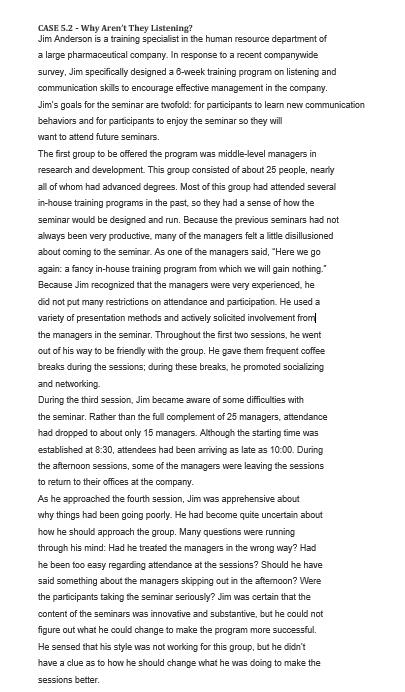Why Arent They Listening? Answer the questions at the end of the case study. Use the following case model as appropriate: Identify the Main Characters

Why Aren’t They Listening? Answer the questions at the end of the case study.
Use the following case model as appropriate:
- Identify the Main Characters (those who play a major role in the case).
- Trace the Chronological Series of Events
- Isolate the Problems or Situations; (s) means more than one
- Propose the Solution (s) to the Problem (s) based on facts in the case and your personal and educational experience. Ask, “What options might be available”? Political and policy challenges may occur if stakeholder support is not taken into consideration in proposing a solution.
- Explore for a Root Problem. Differentiate between the possible “root problem” and “symptom”. Occasionally, the identified root problem is a symptom rather than a root problem. For example, a 20 percent personnel turnover rate in an organization would be considered “extreme”, and at first glance, perhaps present a problem to be solved. Yet, if one is examining the turnover rate, in a seasonal operation, a 20 percent turnover rate may be acceptable.
- Root Solution. What is the most feasible solution/option based on the organization’s resources; which will best satisfy the stakeholders? Your assessment of the case study depends on the facts and your reasoned argument.
CASE 5.2 - Why Aren't They Listening? Jim Anderson is a training specialist in the human resource department of a large pharmaceutical company. In response to a recent companywide survey, Jim specifically designed a 6-week training program on listening and communication skills to encourage effective management in the company. Jim's goals for the seminar are twofold: for participants to learn new communication behaviors and for participants to enjoy the seminar so they will want to attend future seminars. The first group to be offered the program was middle-level managers in research and development. This group consisted of about 25 people, nearly all of whom had advanced degrees. Most of this group had attended several in-house training programs in the past, so they had a sense of how the seminar would be designed and run. Because the previous seminars had not always been very productive, many of the managers felt a little disillusioned about coming to the seminar. As one of the managers said, "Here we go again: a fancy in-house training program from which we will gain nothing." Because Jim recognized that the managers were very experienced, he did not put many restrictions on attendance and participation. He used a variety of presentation methods and actively solicited involvement from the managers in the seminar. Throughout the first two sessions, he went out of his way to be friendly with the group. He gave them frequent coffee breaks during the sessions; during these breaks, he promoted socializing and networking. During the third session, Jim became aware of some difficulties with the seminar. Rather than the full complement of 25 managers, attendance had dropped to about only 15 managers. Although the starting time was established at 8:30, attendees had been arriving as late as 10:00. During the afternoon sessions, some of the managers were leaving the sessions to return to their offices at the company. As he approached the fourth session, Jim was apprehensive about why things had been going poorly. He had become quite uncertain about how he should approach the group. Many questions were running through his mind: Had he treated the managers in the wrong way? Had he been too easy regarding attendance at the sessions? Should he have said something about the managers skipping out in the aftemoon? Were the participants taking the seminar seriously? Jim was certain that the content of the seminars was innovative and substantive, but he could not figure out what he could change to make the program more successful. He sensed that his style was not working for this group, but he didn't have a clue as to how he should change what he was doing to make the sessions better.
Step by Step Solution
3.44 Rating (160 Votes )
There are 3 Steps involved in it
Step: 1
Why Arent They Listening 1 What style of leadership is Jim utilizing to control the seminars In response to a current companywide review Jim Anderson created a sixweek training program on communicatio...
See step-by-step solutions with expert insights and AI powered tools for academic success
Step: 2

Step: 3

Ace Your Homework with AI
Get the answers you need in no time with our AI-driven, step-by-step assistance
Get Started


